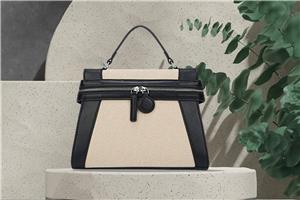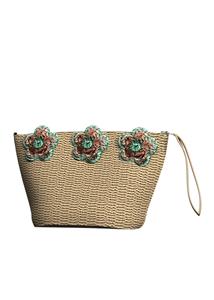Global Straw Weaving Market Surges 300% Amid Eco-Fashion Boom
Global Straw Weaving Market Surges 300% Amid Eco-Fashion Boom

Straw weaving trends have triggered an unprecedented 300% surge in the global market, with revenue reaching $18.85 billion. This dramatic growth shows how consumer priorities have moved toward environmentally responsible, artisanal fashion choices.
Traditional straw weaving techniques now evolve into sophisticated designs, as luxury brands accept new ideas about this versatile material. The market for straw weave products has expanded from everyday accessories to high-end fashion statements. Innovative straw weaving bags have become essential items that blend timeless craftsmanship with modern esthetics.
Environmental awareness, technological advancements in production, and appreciation for handcrafted excellence propel this market expansion. We see sustainability, luxury, and traditional craftsmanship join together to revolutionize fashion's future.
Straw Market Achieves Record $18.85 Billion Revenue
The global straw market has shown remarkable growth and reached $18.85 billion in 2024. The market expanded at a compound annual growth rate (CAGR) of 6.5%. Market experts suggest it will grow further to $24.42 billion by 2028.
Asia Pacific Leads Global Market Growth
Asia-Pacific has become the powerhouse of the global straw market. The region's success comes from its strong manufacturing base and growing consumer interest in eco-friendly options. China holds the top spot and should reach $1.60 billion by 2030. India shows promising growth with an expected CAGR of 19.4% through 2030.
Eco-conscious Consumers Drive Demand
Environmental awareness among consumers has become the most important factor driving the market. So, the market has moved toward sustainable options, with several factors pushing this growth:
Stricter regulations on single-use plastics
Corporate commitments to zero-waste initiatives
Rising governmental support for green products
The quickest way to produce biodegradable products
On top of that, the beverage industry's growth has boosted market expansion, as straws remain crucial for both alcoholic and non-alcoholic drinks. The foodservice sector looks particularly promising with an expected CAGR of 23.2%. This growth matches consumer priorities and the rising need for sustainable packaging solutions.
Luxury Brands Transform Traditional Straw Weave
Luxury fashion houses have turned traditional straw weaving into premium accessories, which marks a radical alteration in high-end fashion. Gucci leads this change with an exclusive collection of straw bags, including the Cestino Tote and Bamboo Shopper series.
Gucci Launches Premium Straw Weaving Collection
Gucci's premium straw collection showcases sophisticated designs that blend traditional craftsmanship with modern luxury. The Bamboo Shopper series pairs natural straw with premium leather accents and iconic bamboo handles. The brand's Soho Chain Strap collection adds straw to contemporary design elements, which creates versatile pieces for casual and formal occasions.
Artisans Perfect Modern Straw Weaving Technique
Expert artisans have refined straw weaving techniques that match luxury market standards. These skilled craftspeople combine traditional methods with fresh approaches to create durable, high-quality products. Fair trade practices ensure artisans get proper compensation while preserving their cultural heritage.
Sustainable Fashion Houses Embrace Natural Materials
Sustainable fashion houses now use natural straw materials because of their environmental benefits. The industry values eco-conscious materials that deliver both sustainability and style:
Toquilla straw and seagrass for their biodegradable properties
Raffia palm fibers known for flexibility and durability
Hemp fibers valued for strength and sustainable cultivation
These materials help environmental conservation and traditional craftsmanship. Luxury brands keep exploring new ways to add these sustainable materials to their premium collections.
Technology Revolutionizes Straw Production
Machine learning algorithms have revolutionized traditional straw weaving into a precision-driven process. These systems analyze big amounts of production data to optimize manufacturing patterns and minimize waste. Manufacturers now achieve 43% higher efficiency in straw processing thanks to this technological breakthrough.
AI Optimizes Manufacturing Efficiency
AI systems boost straw production through up-to-the-minute monitoring and predictive analytics. Manufacturers can detect and fix production problems instantly, which leads to a 24% increase in carbon sequestration efficiency. Smart systems automatically adjust operating parameters to maintain optimal production conditions.
Machine learning algorithms provide these benefits:
Automated pattern recognition for consistent weave quality
Predictive maintenance reducing downtime by 32.63%
Up-to-the-minute optimization of resource utilization
Boosted production scheduling efficiency
Smart Factories Enhance Quality Control
Smart factories have changed quality control in straw production through automated inspection systems. Advanced imaging technology and sensors continuously monitor product quality and detect minor imperfections that human inspectors might miss. Smart factory solutions have improved product quality consistency by 13.67%.
Digital quality control systems analyze multiple parameters at once, from weave density to material consistency. These automated systems excel at detecting surface defects, which ensures only high-quality products reach the market. Manufacturers can now maintain precise control over straw moisture levels and processing conditions - crucial factors for producing premium-quality weaves.
Emerging Markets Reshape Industry Landscape
Straw weaving innovation is taking new directions in markets throughout Africa, Latin America, and Southeast Asia. These regions blend their expertise and time-honored techniques with modern market needs to create unique products and green practices.
African Nations Expand Straw Weaving Capacity
Ghana's Upper East Region is at the forefront of African straw weaving growth with its community-driven initiatives. African Straw Enterprise Limited (ASEL) has substantially improved the lives of over 5,000 basket weavers. Local farmers now grow vertiver grass on a seven-acre farm in Bolgatanga Municipality to ensure a steady supply of materials.
The Trade Aid Integrated project wants to grow straw on 30 acres across seven communities. This initiative helps with climate change adaptation and preserves traditional craftsmanship. Women's groups with 75 skilled artisans thrive through these green farming methods.
Latin America Develops Unique Straw Weaving Bags
Latin American artisans craft distinctive straw weaving bags from native Iraca palm trees. Colombian craftspeople turn resistant Iraca straw into intricate designs with their expert skills. They mix ancient techniques with regional traditions to create unique patterns that showcase their cultural heritage.
Mexican artisans from Sierra Madre in Guerrero use sustainable palm leaves in their work. Their handcrafted pieces display traditional weaving techniques that have passed through generations and help fair-trade practices and local economies.
Southeast Asian Craftsmen Lead Innovation
Southeast Asian textile production shows remarkable innovation in straw weaving techniques. The region's contributions to global straw craftsmanship include:
Traditional weaving blends with modern needs in daily life
Careful crafting processes begin with raw material growth
Government programs help develop skills
Southeast Asian innovations thrive thanks to the region's varied ecosystems that provide many raw materials. In spite of that, these artisans keep their cultural stories alive while accepting new technology. This approach makes them essential players in the sustainable artisanal economy.
Conclusion
Straw weaving has become a soaring win that grew from traditional craftsmanship into a thriving $18.85 billion industry. Your growing interest in eco-friendly fashion sparked an unprecedented 300% market surge. The Asian-Pacific regions lead this expansion, while luxury brands lift straw products to new heights of sophistication.
AI-driven smart manufacturing will give premium quality that makes your favorite straw accessories more durable and refined than ever. Markets in Africa, Latin America, and Southeast Asia bring fresh viewpoints to this ancient craft and add unique regional touches to modern designs.
The future shines bright for straw weaving as people welcome eco-conscious fashion choices. You can explore our extensive collection of artisanal straw products on our website where traditional craftsmanship meets contemporary style. Market projections of $24.42 billion by 2028 show that your eco-friendly fashion choices shape a greener, more artistic future for everyone.
FAQs
Q1. What is driving the surge in the global straw weaving market?
The global straw weaving market has experienced a 300% surge, reaching $18.85 billion in revenue, primarily due to increasing consumer demand for sustainable and eco-friendly fashion choices. The rise of eco-conscious consumers and the adoption of straw weaving by luxury brands have significantly contributed to this growth.
Q2. How are luxury brands transforming traditional straw weaving?
Luxury brands like Gucci are elevating straw weaving by incorporating it into premium accessories. They're combining traditional craftsmanship with modern design elements, creating sophisticated products like the Bamboo Shopper series that blend natural straw with premium leather and iconic bamboo handles.
Q3. What role does technology play in modern straw production?
Technology has revolutionized straw production through the use of AI and machine learning. These advancements have optimized manufacturing efficiency, improved quality control, and increased production efficiency by 43%. Smart factories now use automated inspection systems and sensors to ensure consistent product quality.
Q4. How are emerging markets contributing to the straw weaving industry?
Emerging markets in Africa, Latin America, and Southeast Asia are reshaping the industry landscape by blending traditional techniques with modern market demands. For example, Ghana is expanding its straw weaving capacity through community-driven initiatives, while Latin American artisans are creating unique straw weaving bags using native materials like Iraca palm.
Q5. What are the environmental benefits of using straw products?
Straw products offer several environmental benefits as they are often biodegradable and made from renewable resources. Unlike plastic alternatives, straw items typically have a lower carbon footprint and contribute less to landfill waste. The shift towards straw products aligns with global efforts to reduce plastic usage and promote sustainable consumer choices.




